
Recently, via a long, convoluted and unrelated Google search, this new and curious image at right popped up on my screen. As always, I stopped to save it and investigate. The caption said “Gene Mitchell with harp guitar at ‘Gene’s Guitar Shop’ Judah Street, San Francisco July, 1980.”
My immediate thought: “Hey, that’s where I found my first Knutsen!”
A beat later: “Hey, that’s my harp guitar!”
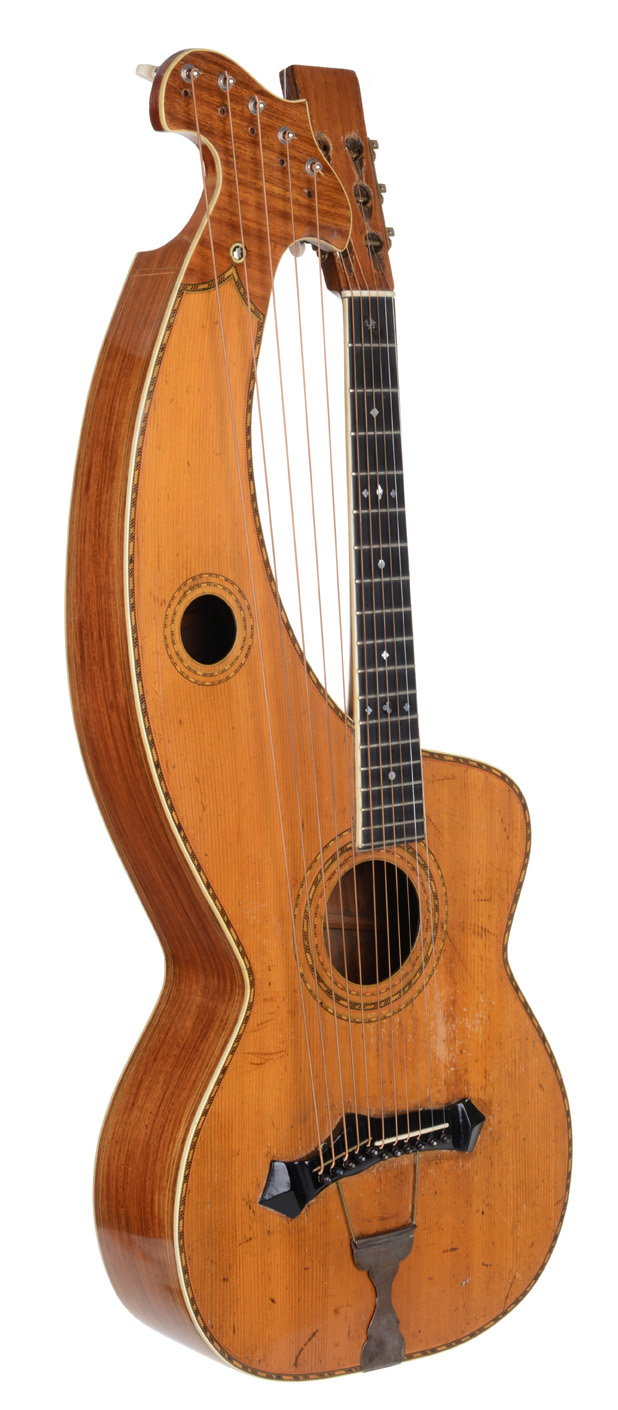 It was recognizable of course by the added tailpiece. And everything else matched.
It was recognizable of course by the added tailpiece. And everything else matched.
The man holding it – Gene – I somehow didn’t quite remember…I thought I remembered an older fellow…? That was in 1988.
Tracking down the person who posted the photo (Daniel D. Teoli Jr.), he said he had gotten the image from his old friend Yodeling Dick, who he put me in touch with. Dick kindly sent me a couple more photos and the story below, which I’d like to share with you – and by so doing, archive on the web for posterity, as there is currently virtually nothing on the Internet on Gene or the shop. They sure changed my life.
The older gentleman I had remembered was Gene’s musical partner Mateo (last name forgotten), who played the mandolin. I remember him there showing me an early Orville-label Gibson mandola with an inlaid pickguard, something I had never at the time encountered.
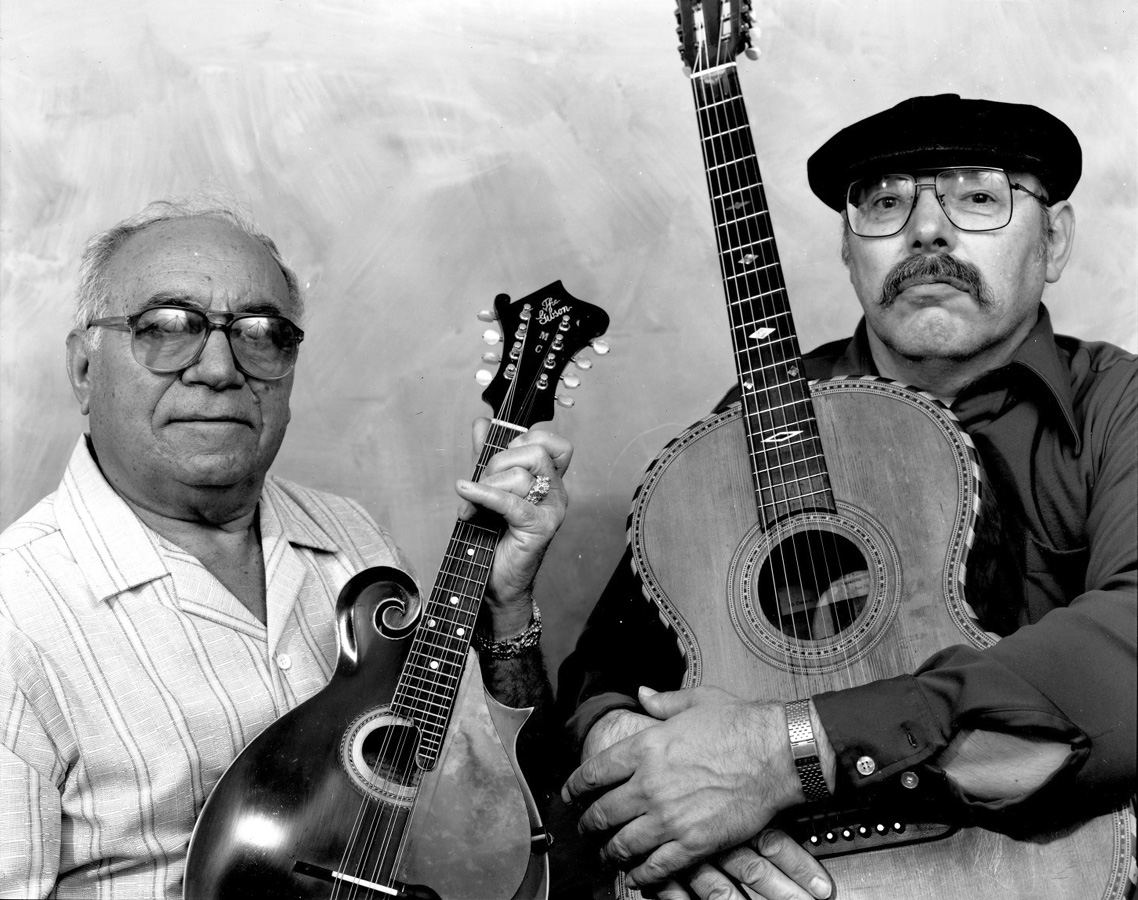
This is a photograph of Mateo (with a Gibson mandolin or mandola) and Gene around the time I visited them. My wife remembered Gene better than I had.
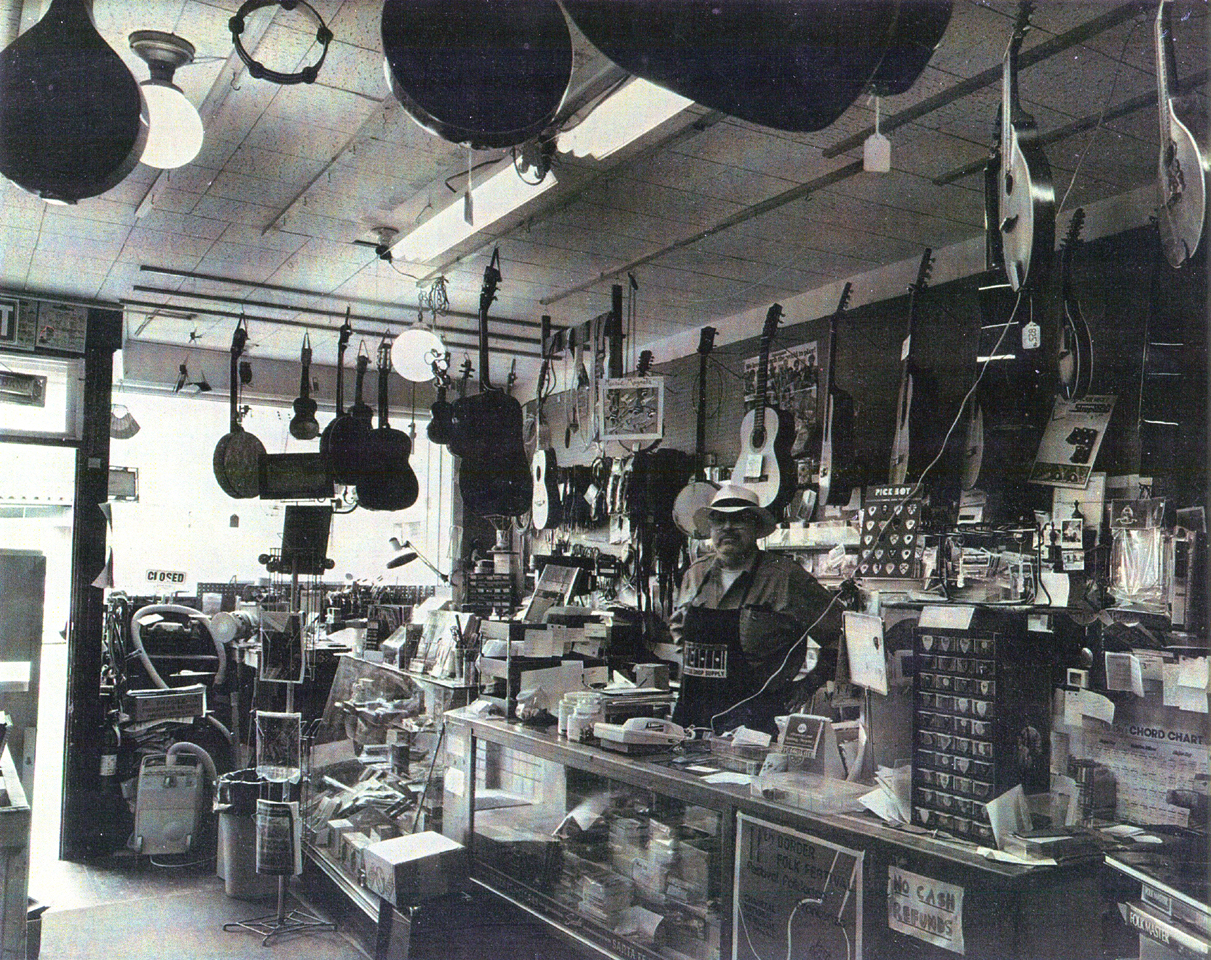
And here’s a hard-to-see Gene in his shop in May, 1993.
Dick explained:
“I am Richard Bruce Morriale, aka: Yodeling Dick Brooks of WWOV 101.1 FM in Wheeling, WV. I knew Gene Mitchell (one of many variations of his name throughout the years) most of his life. He was a dear friend. We met in Brooklyn, NY when we were just kids, about 1943. Gene showed me my first guitar chords when he was 12 and I was 15. My Dad bought me a guitar and in 4 weeks I was on the stage of the RKO Madison in Ridgewood Queens, NY, with a variety troupe playing in-between the movies. That was 1949 and I have never stopped performing in public. Gene was with me much of the time in the early 1950s. Then he joined up with Rusty Evans (Marcus Uzilevsky), who became a singer-songwriter, producer and artist. In later years in San Francisco his art was used as the cover of an LP that Gene played guitar on with his partner Mateo. I have a photo of Rusty, Gene and me when Gene was packing to move to San Francisco in the early to mid-1960s. Soon, Gene opened up his ‘Guitar Shop’ there. In the meantime, I was on different radio stations in New York, New Jersey, Florida, Colorado, Arizona, finally moving to Wheeling, West Virginia in 1988. When Gene closed his shop, he came here and stayed with us for a while until we helped him get an apartment of his own. He arrived January 25th 2003. After communicating with his son, he visited them in Carolina, when his son asked Gene to come live near them. He left for Carolina August 30, 2004 to live in an assisted living facility and passed away on August 26, 2005.
“My Facebook account is Dick Morriale. I have a Radio Broadcast Saturday Mornings at 9:00 to 10:00 am, EST at WWOVFM.COM on the Internet called “The Old Country Record Shop” in which I play what I call ‘the finest in Mountain, Hillbilly, Country, Western, Folk, Gospel, Novelty, Blues, Early 20th Century and World Music,’ and sing a song now and then. Yodeling Dick, Oct. 18, 2019”
My own story is from 1988. Jaci and I had recently gotten back together, and before our marriage in 1989 I spent a lot of time in the Bay area where she lived in San Jose/New Almaden. On one of our many adventures, she went instrument shopping with me. We went to all the guitar stores I could find, most of which were new to me (on this same trip, we got to climb around in Gryphon’s attic space, where I found my Gibson mandobass). This was before the Internet; I was probably using the yellow pages.
 Quick recap: I acquired my first harp guitar – the red ‘teens Gibson – in 1983. I had learned the name “Chris Knutsen” from a harp guitar hanging in McCabe’s Guitar Shop in Santa Monica, and later from Bob Hartman’s Larson brothers book Guitars and Mandolins in America. So, the second I walked into Gene’s shop, I immediately spotted what I knew was a Knutsen Symphony harp guitar hanging on the wall, thinking “Please let it be for sale” and then “please let it be affordable.” It was, and it was. I got both it and the Monzino harp mandolin (below) – both on my original A Christmas Collection CD) for $2200 total. Thank you, Gene!
Quick recap: I acquired my first harp guitar – the red ‘teens Gibson – in 1983. I had learned the name “Chris Knutsen” from a harp guitar hanging in McCabe’s Guitar Shop in Santa Monica, and later from Bob Hartman’s Larson brothers book Guitars and Mandolins in America. So, the second I walked into Gene’s shop, I immediately spotted what I knew was a Knutsen Symphony harp guitar hanging on the wall, thinking “Please let it be for sale” and then “please let it be affordable.” It was, and it was. I got both it and the Monzino harp mandolin (below) – both on my original A Christmas Collection CD) for $2200 total. Thank you, Gene!

Being the first Knutsen I found and learned about, it would eventually become Knutsen Archives Inventory No. HGT1. (Code for “Harp Guitar Tacoma, specimen #1. Unfortunately, we later discovered that the majority of these early Symphony models – identified by certain unique features – were actually built in Port Townsend.)
 Once re-strung and set-up (it was re-fretted by none other than Rick Turner, then doing repairs in Fred Walecki’s Westwood Music store), I fell in love with this pre-1900s instrument. So have many others. The list of those who agree that this is the greatest-sounding harp guitar on the planet includes myself, Frank Doucette and Scott Holloway. Many other famous fingerstyle players have thrilled to its vibrations as well. It’s one of those instruments that plays itself – light, responsive and exploding with all the overtones and complexities old wood and air can create.
Once re-strung and set-up (it was re-fretted by none other than Rick Turner, then doing repairs in Fred Walecki’s Westwood Music store), I fell in love with this pre-1900s instrument. So have many others. The list of those who agree that this is the greatest-sounding harp guitar on the planet includes myself, Frank Doucette and Scott Holloway. Many other famous fingerstyle players have thrilled to its vibrations as well. It’s one of those instruments that plays itself – light, responsive and exploding with all the overtones and complexities old wood and air can create.
As explained in my book Norwegian Wood, I attribute its magic to the non-original tailpiece, which someone long ago installed as a safety measure. Thank god we all agreed to leave it alone, as it seems to act as a “reverse-tension bridge,” allowing the already-light top to float unencumbered in its own transcendental space. It has to be experienced, resisting all attempts to have its subtle sounds captured, be it on its various solos on the CD or Scott’s video in my museum room. Scott probably got closest recording it further away in his own studio, playing his tune “Kay.”
I’ve since amassed an embarrassment of riches in the museum, but still – I so miss those early days of naivety, happenstance and thrilling discovery. R.I.P., Gene.
Below, additional photos from
Norwegian Wood: The Incredible Imagination and Instruments of Chris Knutsen.

I later replaced the sub-bass friction tuners with 4:1 Waverlys. As an experiment, I removed the original brass screw string guides, realizing that I got slightly more tone and sustain. Starting with Duane Noble, many modern builders have since followed suit. The terrible “carved” holes for the neck tuners is all-Knutsen.

This is the biggest neck heel ever made by Knutsen. Usually there’s not even this slight bulge to provide much surface area for his glue-only neck-to-body joint.
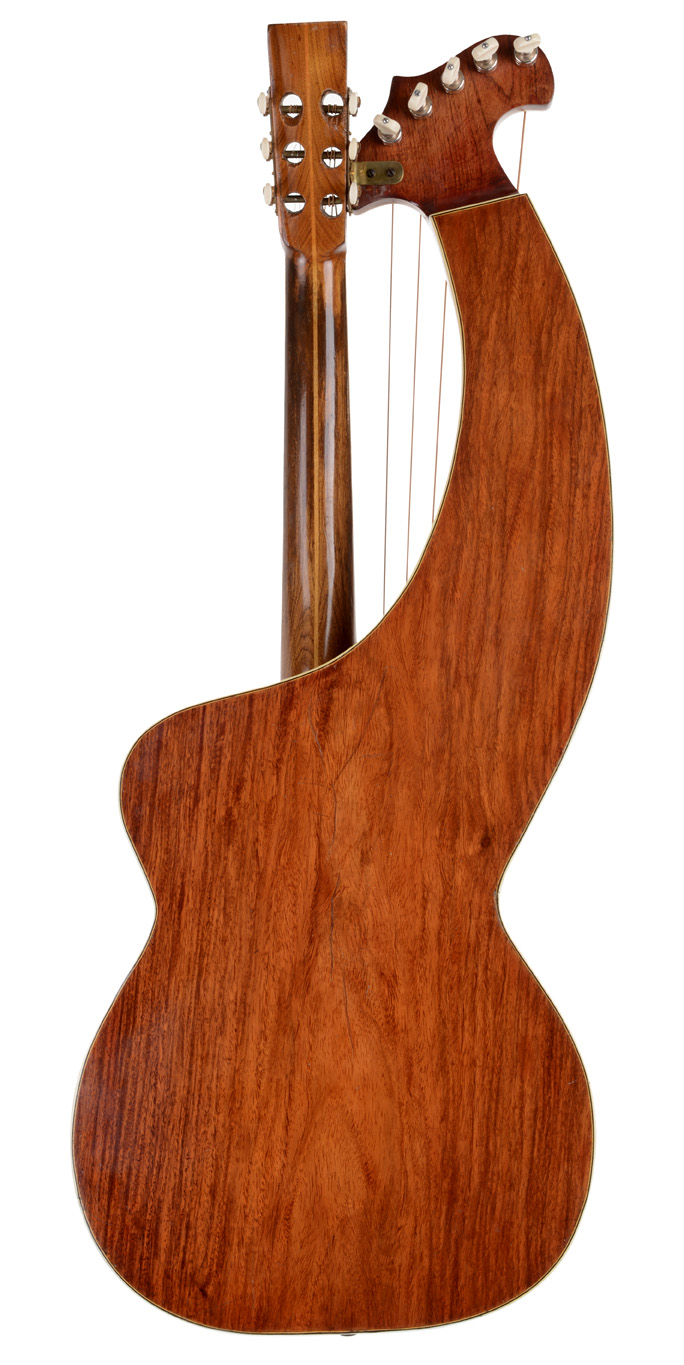
Beautiful satinwood back and sides, the latter inlaid with delicate double colored wood striping.



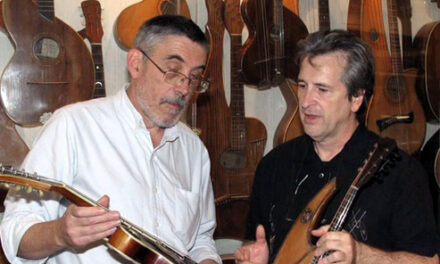


Try Allan Lochead , he was on the Silent Fountain record, maybe he can help you further, good luck with you’re project!!!!
It’s great to see Gino as a much younger man. I met Matteo and Gino in the early 1980s and we gigged together (weddings etc). They’d come down to Caffe Trieste on Saturdays in San Francisco’s Italian neighborhood and I’d go listen to them during lunch hour at the Embarcadero.
The night Gino closed his store, he called me in the afternoon and said ‘get down here’ and buy stuff. He really was just giving away everything. He gave me a Sicilian pearl-inlaid guitar, lots of ballo liscio sheet music, and more. He was sick and tired of paying exorbitant rent. He was anxious to leave the City. It was a slow slide in the 1990s. After Rudy’s shop was demolished (and the access he had to a shower etc) he was just barely surviving as he slept in the back room (a room he previously used as a music lesson studio). He only had a hot plate. It was very, very sad to watch him lose customers and not be able to pay rent. Whatever he didn’t sell that night, he just left to the Chinese landlord who must have sold everything or just took to the dumpster after he gutted the store. Gino was never sadder than when he exited the store.
What a wonderful story how you made such a cool and unexpected discovery.
Vey cool story, in the days before the internet it was a lot of fun to look for instruments.
I wouldn’t trade those days for anything…